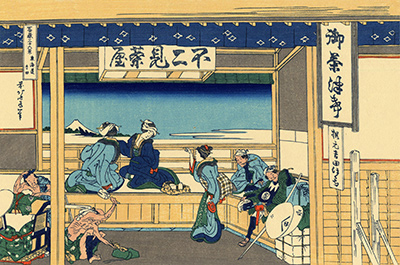Hokusai
Yoshida at Tokaido by Hokusai
Yoshida on the Tōkaidō or Tōkaidō Yoshida, is one of Katsushika Hokusai’s paintings from the series Thirty-six Views of Mount Fuji also called Fugaku sanjūrokkei and has been tagged in the group-portraits in most exhibitions. The Japanese artist was born on October 1760 in the Tokyo, Edo District and died on May 1849.
The artistic culture behind the artwork is borrowed from the Edo period (1615-1868) when the Japanese society believed that The Mount Fuji had secret immortal powers. Hokusei, artists, and historians of the time were virtually fascinated by the cone of the Volcanic Mountain that they came up with different perceptions of its nature through paintings that depicted various seasons, conditions, weathers, and locations. The Yoshida at Tokaido was produced in ca. 1830-1868 by Hukosei using an Ukiyo-e style in Japan. The print was created on a Polychrome woodblock print; ink and colour on paper with dimensions of H. 10 1/8 in. (25.7 cm); W. 15 1/4 in. (38.7 cm).
In the print Hukosei depicts a scenic location on a teahouse called Fujimi Chaya, which translates to a teahouse with a view of Mount Fuji. The name is also written on the horizontal panel at the center of the print. There are two women who seem to be enjoying the Vista of Fuji. It has a triangular arrangement of figures in the foreground who represent the shape of The Mount Fuji. The print was published by Nishimura Yohachi from Japan. The publication of the print in other recent exhibitions such as the Landscape in Japanese Art, of 2002 that was published by Hibino Yohachi. This particular print has been done on dimensions of 25.8 x 37.5 cm (10 1/8 x 14 3/4 in,), on a colour wood block print; Oban.
Katsushika Hokusai learned part of his painting from his mirror-maker farther Nakajima Ise who used to make some paintings on the frames of his mirrors. Although he was originally born Tokitaro, Hokusai had more than thirty other names during his entire career. He was so passionate about The Mount Fuji that he came up with The Thirty-six Views of Mount Fuji series that had amazing unique prints of The Mount Fuji from different locations.
